Know Exactly How to Improve Your Clients’ Reputations in 2021
Did you know that 91 percent of people trust online reviews as much as personal recommendations? Keep that statistic in your back pocket for the next time your clients ask you whether managing reviews to improve their online reputation is really all that important.
In a digital world that moves at warp-speed, information about a business spreads faster than ever before, and consumers are at the center of the conversation. With information accessible at their fingertips, consumers can discover and share everything about a business—and fast.
Agencies and media companies understand the importance of online reputation management: that it’s no longer a “nice to have” but a necessity. However, the concept of online reputation is an intangible, ever-changing thing that many struggle with—even those who are professionals in the field. It can be difficult to measure reputation and hard to know for sure whether it’s improving. And if it’s something I can’t touch or feel then does it really exist? Absolutely it does. And Vendasta has a new way for professionals to quantify a client’s success to improve an online reputation.
Why is a business reputation important?
Before diving into how to improve an online reputation, let’s cover the basics. A business's reputation is important because consumer buying decisions are heavily influenced by it. Research shows 88 percent of people say they read reviews before making a purchase decision. It’s now the first step in the modern customer journey and, without a positive online reputation, people will likely turn to the more highly regarded competitor down the road with similar products.
It’s not enough to have a great product or service—consumers want to buy from a business with a great reputation. An active social media presence, shiny customer reviews, and a strong search engine optimization (SEO) presence help a business stand out from the rest.
On the flip side, if people have a negative perception of the business, they're not likely to make a purchase and may write negative feedback on a public review site, effectively damaging the future impressions other consumers may have about the business. Keep reading for details of how to build and improve an online reputation.
What affects a business’s online reputation?
1. Being found online where your clients’ customers are looking
Consumers won’t become loyal customers if they can’t find the business online because that’s where 97 percent of people are looking to learn more about a local company. This makes having correct and consistent online listings a vital first step in improving online reputations. It may seem pretty simple but you would be surprised to learn the number of businesses without online listings, or worse, outdated ones.
2. Reviews that help customers choose your clients over the competition
There was a time when direct word-of-mouth was the best way to spread opinions about a business. Now, it all happens digitally, in the form of online reviews. Research shows 81 percent of consumers do their research online before making a purchase in-store, and online reviews are one of the quickest ways to gather information about a business.
3. The business’s response to those reviews
Just as important as those customer reviews is how a business responds to them. Following best practices for responding to reviews, good and bad, is an often overlooked aspect of managing and improving reputations. But, letting a negative review fester without acknowledgement can be detrimental to a business’s reputation and may give the impression that they clearly don’t care about remediation
4. A consistent online presence
Your clients’ online presence should be consistent across their website, review sites, social media, and Google Q&A—really anywhere they’re communicating with current and potential customers. Maintaining an online presence means posting on social media, responding to customers on social media and Google Q&A, maintaining a website, and responding to reviews.
5. What others say about their business online
As Warren Buffet famously said, “It takes 20 years to build a reputation and five minutes to ruin it.” Businesses need to be just as much on the defence as the offence when it comes to managing online reputations. Business owners need to be vigilant when their business and employees are mentioned online as the internet is a wide-open space where anyone can express any opinion on social media and news sources. Snuffing out negative stories and promoting the positive ones is an essential part of reputation management.
How to measure a business’s online reputation
When it comes to increasing a business’s reputation, it’s important to first understand where the business started out—perhaps before they employed your company to help. There are many things that can affect a business’s reputation and it is difficult to distill these into a single metric.
Vendasta’s Review Grade is one solution that is helping more than 500,000 small- and medium-sized businesses understand the most important factors that impact their online reputation. It’s also helping our channel partners communicate the value of their software and services. Delivered in a client’s weekly or monthly Executive Reports, the Review Grade shows proof-of-performance and creating loyal clients who are obsessed with the improvement they’re seeing, thanks to your company’s help.
See where they stand today
Based on Google’s method of local search rankings, the Review Grade takes into account several factors including, review quality, quantity, and frequency, giving businesses a quantifiable way to assess their reputation. Before working with your company, it’s likely your clients will have a mediocre score. But this is exactly the purpose of the Review Grade: to open the door to a deeper discussion and analysis of specific factors impacting their score and tactical ways to improve their reputation.
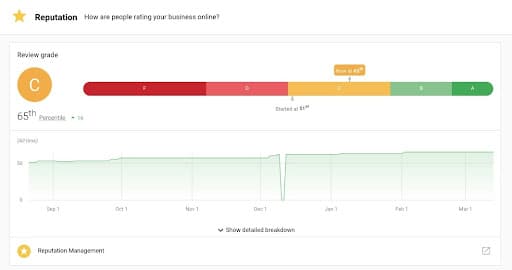
How is the Review Grade calculated?
The Review Grade is calculated based on the business’s performance in four categories:
- Average review score
- Number of review sources
- Total reviews found
- Number of reviews found per month
Scores in each category are then combined and compared to the industry average to produce a final letter grade using a percentile grading system.
- A = 90-100th percentile
- B = 75th-89th percentile
- C = 50th-74th percentile
- D = 30th-49th percentile
- F = 0-29th percentile
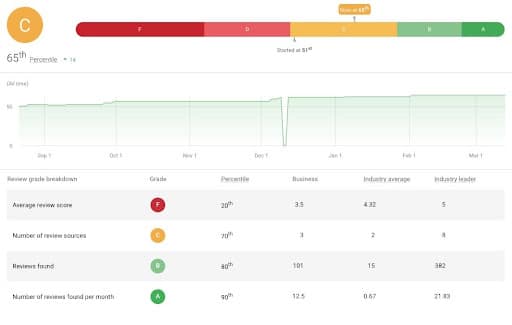
Let’s dig into why each of those elements in the calculation matters and how to help your clients improve their online reputation in an effort to boost their Review Grade.
Quality wins: Why positive reviews matter
Online reviews must be of high quality and high star rating. A high star rating does triple duty when it comes to online reputation. Businesses with more positive reviews earn higher revenue, have a better overall reputation, and higher search engine ranking. Did you know that a single star rating increase could mean roughly 9 percent more in revenue? On the other hand, Forbes cites 94 percent of consumers choose to avoid a company based on their negative reviews. When it comes to search engine optimization, earning more positive reviews is a great way to get your client’s business to earn that coveted #1 search ranking spot which gets 31.7 percent of all clicks on Google.
More is better when it comes to positive reviews
Can there ever be too much of a good thing? If we’re talking about positive online reviews, the answer is, no. High volumes of positive reviews encourage trust and help to mitigate the impact of negative reviews with potential customers. When shoppers search for a business, they expect to read current reviews, and if there aren’t any, they may assume the business isn’t all that great or doesn’t have a significant customer base.
Keep them coming: Why review frequency matters
Shoppers tend to look for new, updated reviews that indicate whether old issues have been resolved. Sixteen percent of consumers consider reviews too old after three months, 36 percent after six months, and 65 percent after a year (Trustpilot). Without frequent reviews to replenish the feed, old and outdated reviews will continue to be shown, and likely won’t accurately reflect a business’s current reputation or the experiences of recent shoppers. Search engines also recognize when businesses are being talked about. The frequency of those reviews is an indication of a business’s good reputation and credibility, and it’ll be rewarded with higher search ranking.
How to improve a business’s online reputation
Once your clients have received a few Executive Reports and seen changes to their Review Grade, it’s time to assess how they got there. Did the grade drop because the industry average for the number of review sources is now five instead of four? Or, is the sudden boost due to the influx of new reviews from last month’s campaign? Here’s what to do next. If your clients are seeing a few more C and D grades than they’d like, consider these ways to boost ratings for the next Executive Report:
- Ask for reviews: The most tried and true way of boosting your Review Grade is by simply asking customers for reviews. A total of 70 percent of your client’s customer base is likely willing to leave a review if asked. You can request reviews via a website, through email, a text message, or right in-store using Customer Voice Pro. As the ideal complementary solution to Reputation Management Pro, Customer Voice Pro is a reputation-building tool that gives your clients the ability to request customer reviews. A simple link sends them directly to the sources you wish to be reviewed on. Here are 10 sites where you should be asking your customers to leave business reviews.

- Create a review station: If your clients operate a brick-and-mortar location or are a service-based business, the Mobile Kiosk feature in Customer Voice Pro allows them to ask for customer feedback right at the point of sale—when customers are most likely to submit a review. For a rundown on Mobile Kiosk, see the recent article, here.
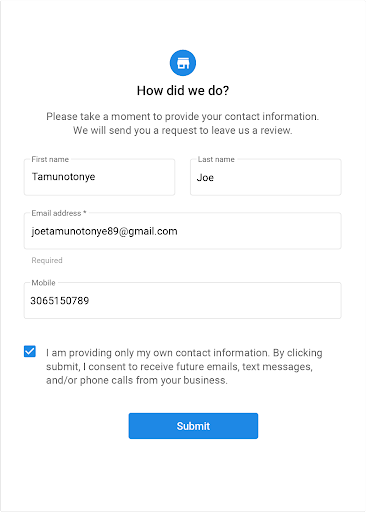
- Embed an email signature: Think about all the times your clients send emails from their business’s branded address. What if every time they sent an email, they were passively encouraging customers to review their business? Yet another feature of Customer Voice Express and Pro, the email signature widget does just that.
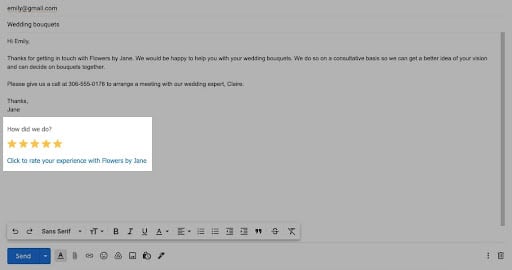
- Respond to reviews: This one might not seem as obvious, but responding to negative reviews can impact future reviews a business receives and even encourage the reviewer to have a change of heart. Moreover, most customers expect a response to their reviews and one in four expect a response within three days.
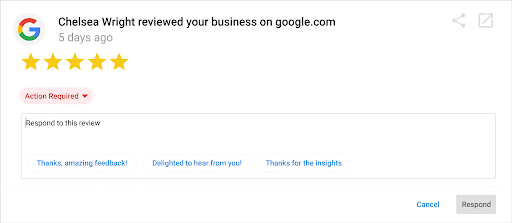
- Improve the business with real customer feedback: This tactic takes time to pay off, but when it does, the gains are exponential. The reviews that clients receive are not just a vanity metric, but actually hold golden nuggets of insight into their customers’ thoughts, feelings, and opinions. Using Insights, powered by Google’s natural language processing, Reputation Management Express and Pro does the heavy lifting, sifting through your client reviews and unearthing the most commonly used keywords and how customers describe those keywords. What you’re left with is a wealth of information into how customers perceive the business, what they love, and what needs improvement. Use these insights to drive business improvements, which in the long run, will result in happier customers and an improved reputation.

Wrapping it up
A solid online reputation is a must, but it can seem impossible to have any effect with all the channels a business needs to monitor and the lawless land that is the internet. Local businesses often look to an expert for help in getting a handle on their online reputation.
You, as an agency, media company or other trusted expert with Vendasta, have the tools to help, including the Review Grade that provides a simplistic way to quantify a good reputation and helps show proof-of-performance over time. It’s a standard component with Reputation Management Express or Pro and is available to you as a Vendasta partner. Not a partner yet? Click the link, below, to sign up to Vendasta for free and start selling reputation management software to your clients, and help them increase their brand reputation.

